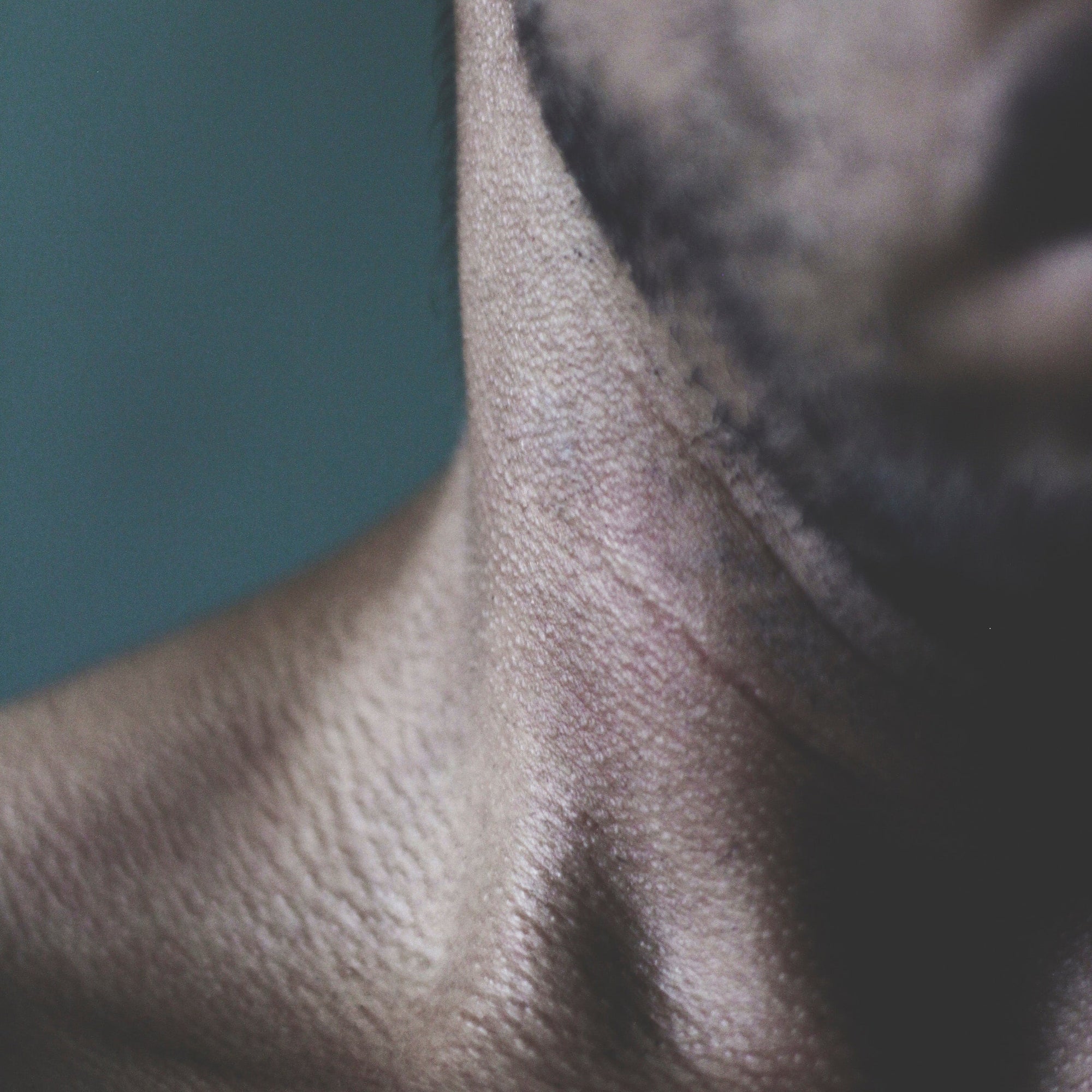Acne breakouts are bad enough…
but the marks and scars they leave behind can make you feel even worse.
Whilst your skin doesn’t have to be completely smooth, these scars can last for months – and you’re allowed to want to get rid of them.
But they can be very stubborn! And no single acne scar treatment is best for everyone.
Don’t worry though. There’s a lot of options available that give excellent results if you happen to be one of those guys with acne scars.
From prevention and at-home strategies to in-office laser treatments, there’s never been more promising technology available to avoid scarring, fade discoloration and reduce the appearance of acne scars.
Scroll down to find out more …

Figuring out what type of acne scars you're dealing with will guide you in the best way to treat them
A man's skin tends to be oilier than a woman’s.
And in many ways that’s great. The oil (or sebum) produced by our sebaceous glands is what keeps our skin (and hair) soft and healthy.
But when these glands are over-active the excess sebum can combine with dead skin cells and bacteria on your skin, clogging your pores and giving you acne!
What causes acne scars?
As the inflammation from a pimple calms down and your skin tries to heal, scar tissue forms which can lead to the skin being disfigured.
Acne can leave several different types of scars.
And figuring out what type you're dealing with will guide you in the best way to treat them.
What type of acne scarring do you have?
Let’s start with the fact that you may not have actual scars at all, just pigmentation marks.
Hyperpigmentation: These are dark spots and discoloration of the skin which are left behind after a zit has cleared. And the good news is that these marks will fade over a few months on their own.
When it comes to actual scarring…
There are four different types of acne scars:
The first three are ATROPHIC (an indented scar that sits below the skins surface).
These are formed when not enough collagen is made while the skin is healing.
- ICE PICK SCARS – small indents that may look like a needle prick but that penetrates deep into the skin.
- ROLLING SCARS - shallow depressions which look like “valleys” in the skin with rounded edges.
- BOX CAR SCARS - wide, U-shaped scars, similar to rolling scars, but with angular, well-defined edges.
Best Treatments for ice pick, rolling, and boxcar scars: A collagen-boosting treatment works best with atrophic scars. When collagen production is boosted, the scar will eventually raise to match the rest of your skin's surface.
- And HYPERTROPHIC (or raised acne scars). These types of scar are rarer and show up as raised bumps that stand above the surface of the surrounding skin.
Best Treatments for hypertrophic scars: Reduction of collagen is key with this type of scar. So options like in-office laser treatments that reduce the appearance and the redness of the scar are the most effective.
You may have several different types of scar so if you’re unsure, it’s worth paying a visit to your dermatologist.
But start with…
Prevention first
It seems obvious but the best way to treat an acne scar is to prevent it happening in the first place.
So start by controlling and treating any ongoing acne first.
Because some acne treatments will help improve the appearance of acne scars as well.
For men, it could be as simple as making sure that you clean your skin efficiently to get rid of any excess oil, and build up of dirt and sweat.
You also want to make sure you that you shave with care, especially if you're prone to acne along the jawline.
We’ve got more on that here – “How to Clear Up Acne on Your Jawline”.
And secondly, avoid picking, popping, or squeezing - no matter how tempting!
Picking at a breakout will easily irritate the skin, causing more inflammation and damaging the tissue, which will lead to scarring.
Also avoid harsh facial scrubs that can further irritate skin.
Sun exposure can make acne blemishes appear darker as well. So it’s important to wear sunscreen of SPF 30 or higher every single day.
Then move on to…

Target discoloration by exfoliating away darkened scar skin cells
Target the discoloration
Because sometimes that’s all you need!
When you even out the color of an acne scar it makes your skin look smooth and clear.
The best at-home strategy for this is regular use of a gently exfoliating face wash that includes an alpha-hydroxy acid (AHA).
Our Daily Face Wash contains Lactic Acid (a mild AHA) to effectively improve skin texture and lighten acne scars.
It will exfoliate away darkened scar skin cells while stimulating collagen production and revealing smoother and more even skin.
And it’s gentle enough to be used every day – even if you have sensitive skin.
Then follow up with a light, non-greasy moisturiser which will soften and smooth your skin, keeping it supple and discouraging scarring.
Our Hydrating Daily Moisturiser also includes a powerful peptide – Matrixyl.
Peptides help to stimulate collagen production. So they improve your skin’s texture and help to reduce discoloration.
It also includes Vitamin E and Aloe Vera to regenerate skin cells and even out skin tone.
Daily Routine for Smooth, Clear Skin
"It's my third day of using your face wash and my skin is looking great! My spot scars were quite dark a few days ago but since using the face wash they've gone way down. The texture of my skin has gotten so much better. My skin is actually smooth now!" - Giorgio, London
At Home Treatments to Erase Acne Scarring
There are a ton of creams and serums available over the counter now.
Look for these active ingredients for the best results:
Retinoids
An acne treatment that also smooths any scars.
But they can make your skin very sensitive to the sun, so ALWAYS wear sunscreen when using anything that contains retinoids.
Milder retinoid creams are available over the counter, but your dermatologist can also prescribe higher concentrations.
Best for: Atrophic (indented) scars and discoloration.
Salicylic acid
Acne responds really well to treatments containing salicylic acid - unclogging pores, reducing inflammation and redness, as well as exfoliating your skin. On top of that it’s also an excellent treatment for getting rid of acne scars.
You can add products with salicylic acid into your daily routine or use it for less frequent chemical peels.
However, you don’t want to unbalance your skin. So it’s better to use a treatment with a low percentage of salicylic acid.
Only target the area where you have a scar, so you won’t dry out the surrounding skin.
And it might take a few weeks to see an improvement.
Best for: All acne scars.
Lactic acid
We’ve already mentioned the effectiveness of Lactic Acid in our Daily Face Wash.
But you can also use it in a more intense concentration in a serum or at-home chemical peel.
Best for: All types of acne scars.
Vitamin C serums
Vitamin C comes packed with antioxidants which are anti-inflammatory and skin brightening so they fade the appearance of acne scars.
Best for: Discoloration
Other ingredients which fade discoloration:
Look for over the counter creams containing hydroquinone and non-hydroquinone lightening agents – such as Tranexamic Acid.
These are proven to help with pigment correction, lightening brown spots and evening out skin tone.
Best for: Discoloration
And one of the best natural ingredients to improve acne and reduce scarring…
Aloe vera

Aloe Vera, one of the best natural ingredients for reducing acne scarring
Aloe Vera works to help with acne scarring on several levels.
Firstly, it reduces any swelling and redness, and stimulates production of new skin cells, so reduces the appearance of acne scarring.
And secondly..
Aloe Vera contains a compound called aloesin that helps to reduce hyperpigmentation in acne scars, making them less noticeable.
You can find Aloe Vera in our Daily Face Wash and Hydrating Daily Moisturizer.
Best for: Healing and discoloration
And finally…
Try In-Office Treatments
If you’ve tried all of the above and the blemish is still noticeable then don’t worry…
There are several professional in-office treatments available that offer excellent results in improving the appearance of acne scarring:
For atrophic (indented) scars - ice pick, rolling, and boxcar scars – discuss a collagen-boosting treatment with your dermatologist. When collagen production is boosted, the scar will eventually raise to match the rest of your skin's surface.
With hypertrophic (raised) scars, you want to reduce the level of the scar. So ask about treatment options that include silicone gel, steroid injections, and lasers (such as the Vbeam laser).
Lasers are the gold standard when it comes to improving acne scars.
Resurfacing lasers
Most significantly, resurfacing lasers are some of the best treatments, particularly for scars that are indented (ice pick, rolling, and boxcar scars).
They fall into two types - ablative (which ‘wound’, removing thin layers of skin) and non-ablative (non-wounding). Both types stimulate collagen growth.
Unfortunately, this treatment is not a good option for anyone who’s still getting breakouts, and it’s not as effective on darker skin tones.
Best for: All acne scars and lighter skin tones.
IPL (intense pulse light) lasers
Photodynamic therapy (light therapy) is great for reducing the inflammation of active acne.
Vascular lasers and broadband light treatments, such as pulsed dye laser or IPL lasers are non-invasive and extremely gentle to the skin.
They can also be used to reduce any discoloration, making scars less noticeable without damaging the outer layer of skin.
Results are subtle, and you might need repeat treatments.
Best for: All acne scars and discoloration on lighter skin tones.
Can lasers be used on darker skin to remove acne scars?
The problem with most lasers is that they work better on paler skin due to pigments, so they aren’t the best bet for darker skin tones.
However, treatment with the Nd:YAG laser has shown promising results.
In addition to lasers, there are other in-office treatments (like medical-grade chemical peels, microneedling and fillers) that can help diminish acne marks and scars.
Chemical peels
A chemical peel is a strong acid that’s used to remove the top layer of skin to reduce deep scars.
Some chemical peels are mild enough to be used at home, but a dermatologist can provide a stronger solution with more dramatic results.
Best for: All types of acne scars, often used for deeper scars.
Microneedling
This is a newer treatment that uses a small, needle-studded roller. The needles puncture the numbed skin. As the skin heals, it makes collagen to raise the scar to the level of the surrounding skin.
Although it sounds scary, it’s actually a safe treatment that works for all skin tones. But the treatment can take up to 9 months before you see results.
Best for: Indented acne scars.
Fillers
A dermatologist uses dermal fillers to fill in each individual acne scar and help even out the skin. The fillers can be made with collagen, your own fat, or a commercial filler. They’re injected under the surface of the skin to help plump up and smooth out indented scars.
The effect lasts between 6 and 18 months before they need to be redone, but some are permanent.
Best for: Someone with a small number of boxcar or rolling scars.
FAQ’s
Is it too late to heal acne scars?
Not at all.
The results depend a lot on the type of scar (and the types of treatment chosen to treat it).
But with patience, and a combination of at-home and in-office treatments you can achieve amazing results.
There’s never been more promising treatment options available.
The Takeaway
Acne scars can be frustrating, but the right treatments can effectively reduce their appearance and smooth your skin.
Start with preventing and controlling any existing acne, then move on to …
- Target discoloration
-
At-Home treatments
You can try products containing Retinoids, Salicylic Acid, Lactic Acid, other lightening ingredients and Aloe Vera, along with Vitamin C serums. -
In-Office treatments
While Lasers (both Resurfacing and Intense Pulse Light Lasers) are the gold standard, you can also ask your dermatologist about Chemical Peels, Microneedling and Fillers, depending on the type of scarring.
With time, patience and a combination of the most promising treatments, you can achieve impressive results.
SHOP THE ROUTINE.
All you need to stay looking handsome.
PRESTIGE SKINCARE FOR MEN.
MADE IN FRANCE.



